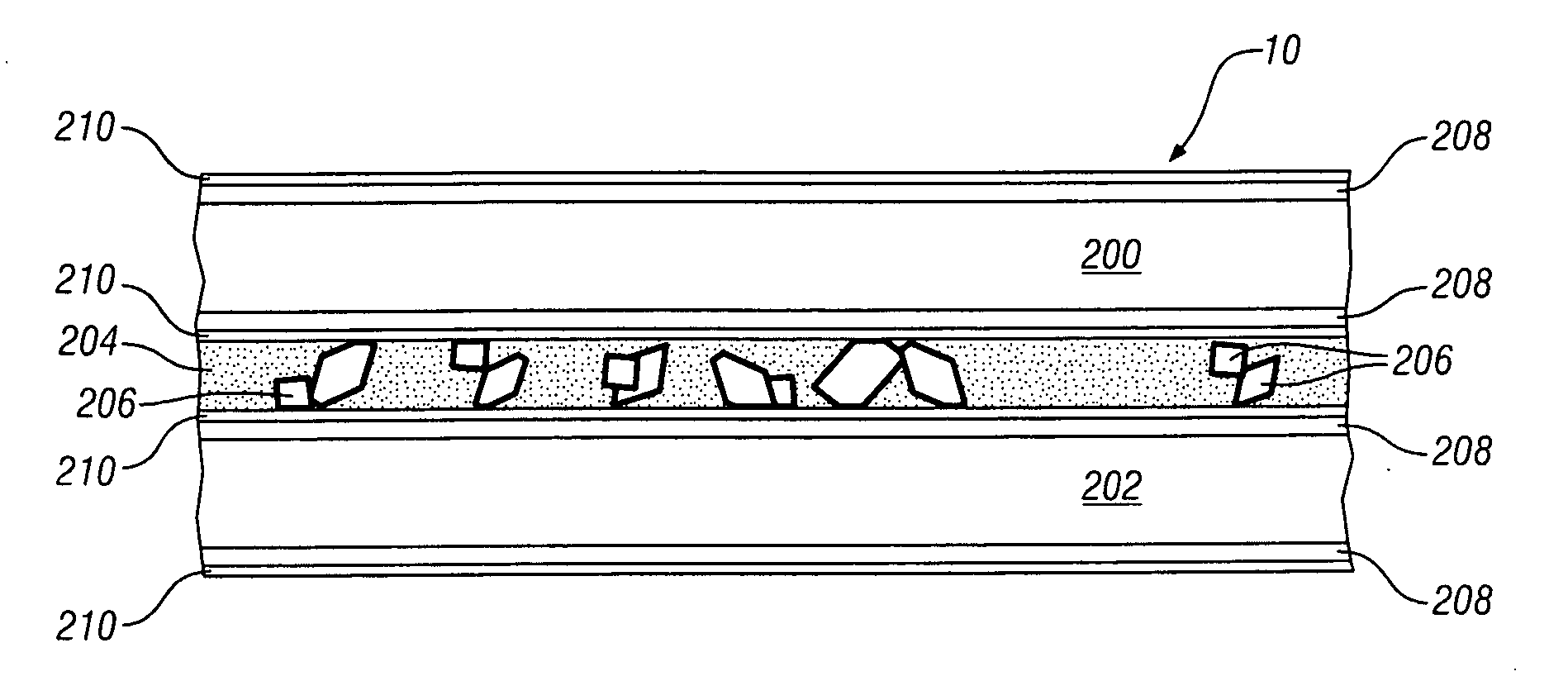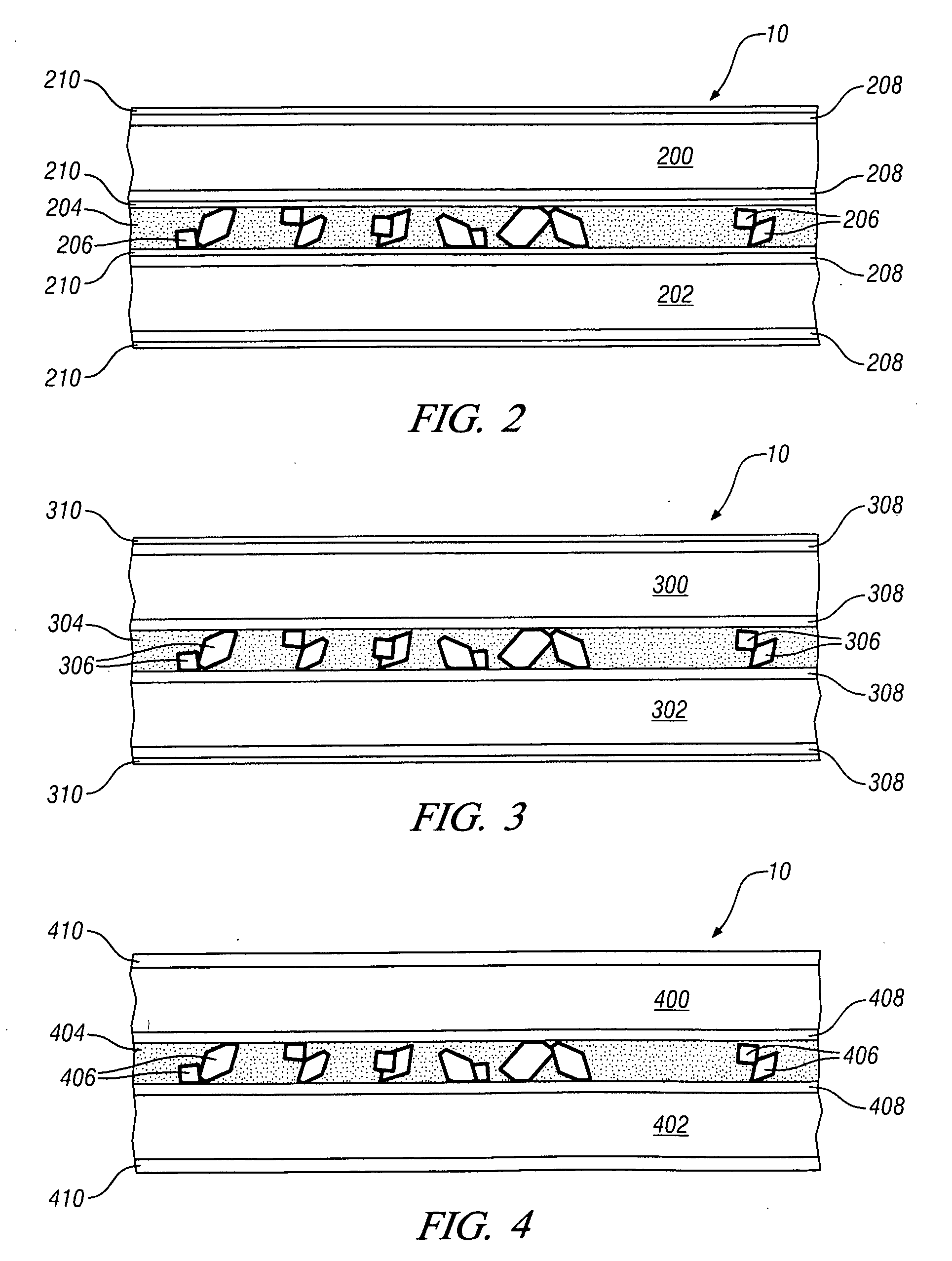Laminated steel sheet
- Summary
- Abstract
- Description
- Claims
- Application Information
AI Technical Summary
Benefits of technology
Problems solved by technology
Method used
Image
Examples
first embodiment
[0039]In a first embodiment, a laminate is produced with steel skin sheets that have both exterior surfaces and both interior surfaces coated with substantially pure zinc and an underlying Zn—Fe alloy coating. The final laminated product has a viscoelastic layer containing conductive particles located between the skin sheets. This laminate is particularly suitable for vehicle body applications.
[0040]The resulting structure is shown in an edge portion (at location 2) of panel 10 of FIG. 1. In this embodiment, the panel 10 steel laminate comprises a first steel skin sheet 200, and a second steel skin sheet 202 that sandwich a viscoelastic polymer core layer 204 that is generally co-extensive with facing surfaces of steel skin sheets 200, 202. FIG. 2 is enlarged for purposes of illustration and not drawn to scale. Each steel sheet 200, 202 may be about 0.5 mm thick and the polymer core layer may be about 0.04 mm thick and coextensive with identical facing surfaces of sheets 200, 202. I...
second embodiment
[0045]In a second embodiment a laminate is produced that has steel skin sheets with Zn—Fe alloy layers on both interior and exterior surfaces. A substantially pure zinc layer is located only on the laminate exterior surfaces. The laminate contains a viscoelastic core with conductive particles.
[0046]The resulting structure is shown in FIG. 3 looking at an edge portion (at location 2) of panel 10 of FIG. 1. In this embodiment, the panel 10 steel laminate comprises a first steel skin sheet 300, and a second steel skin sheet 302 that sandwich a viscoelastic polymer core layer 304 that is generally co-extensive with facing surfaces of steel skin sheets 300, 302. Again, it is seen that each steel skin sheet 300, 302 has a surface facing polymer core layer (termed an inner surface) and a surface opposite the core layer (termed an outer surface). And again polymer core 304 comprises dispersed conductive particles 306 to provide suitable electrical conductivity through the usually non-conduc...
third embodiment
[0051]In a third embodiment, a steel laminate is formed having steel skin sheets with different coatings on the interior and exterior surfaces. The laminate has a galvanized zinc coating applied to the exterior surface and a Zn—Fe alloy coating applied to the interior surface. The laminate is also made using a viscoelastic core that contains conductive particles. The resulting laminate is shown in FIG. 4 looking at an edge portion (at location 2) of panel 10 of FIG. 1.
[0052]In this embodiment, the panel 10 steel laminate comprises a first steel skin sheet 400, and a second steel skin sheet 402 (each about 0.5 mm thick) that sandwich a viscoelastic polymer core layer 404 that is generally co-extensive with facing surfaces of steel skin sheets 400, 402 and about 0.04 mm thick. Again, it is seen that each steel skin sheet 400, 402 has a surface facing polymer core layer (termed an inner surface) and a surface opposite the core layer (termed an outer surface). And again polymer core 404...
PUM
| Property | Measurement | Unit |
|---|---|---|
| Fraction | aaaaa | aaaaa |
| Fraction | aaaaa | aaaaa |
| Thickness | aaaaa | aaaaa |
Abstract
Description
Claims
Application Information
 Login to View More
Login to View More - Generate Ideas
- Intellectual Property
- Life Sciences
- Materials
- Tech Scout
- Unparalleled Data Quality
- Higher Quality Content
- 60% Fewer Hallucinations
Browse by: Latest US Patents, China's latest patents, Technical Efficacy Thesaurus, Application Domain, Technology Topic, Popular Technical Reports.
© 2025 PatSnap. All rights reserved.Legal|Privacy policy|Modern Slavery Act Transparency Statement|Sitemap|About US| Contact US: help@patsnap.com



